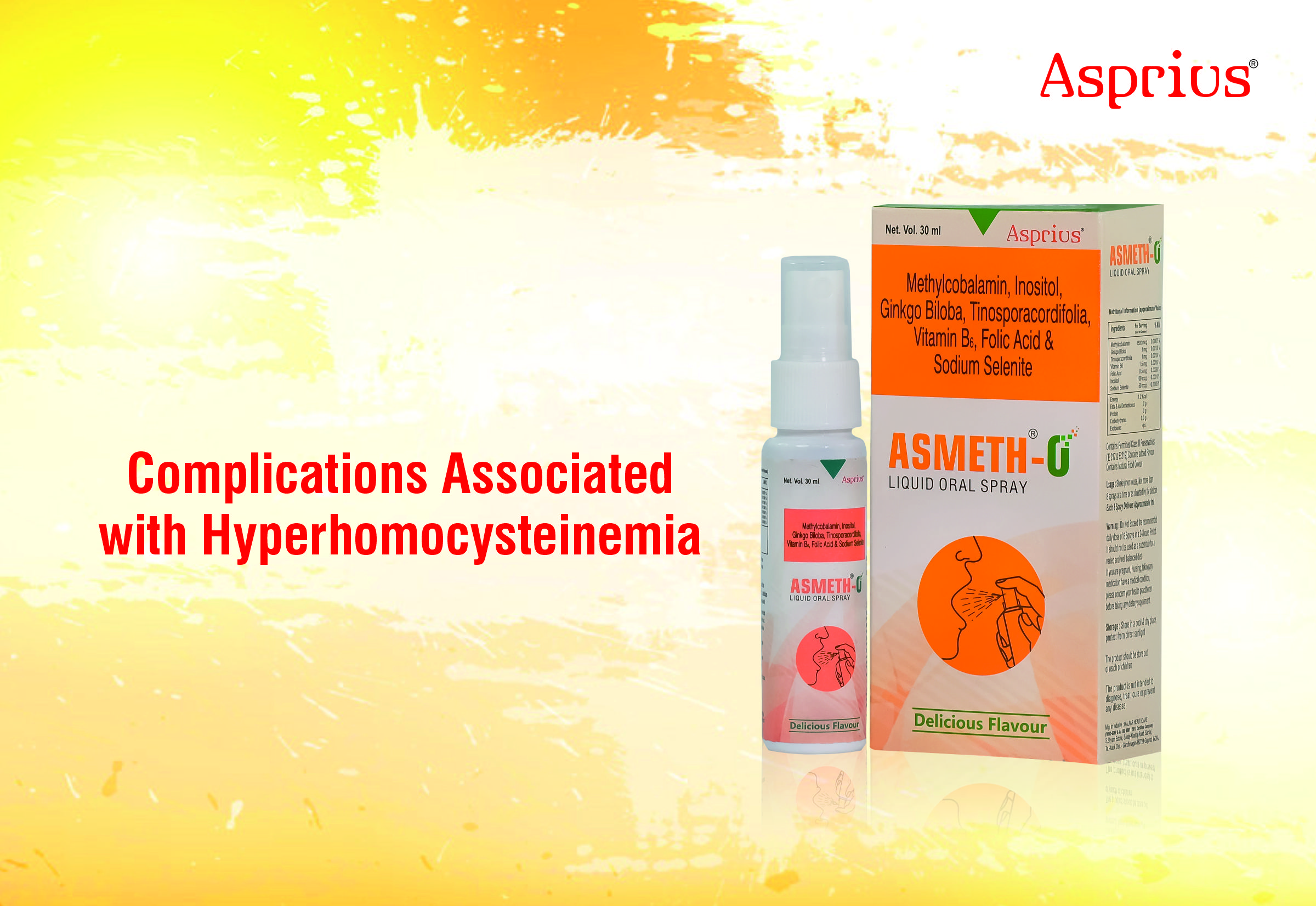
Dr. Sanjay Agrawal
Leading Pharmaceutical consultant and editor-in chief of IJMToday

Hyperhomocysteinemia: Deficiency of cofactors like methylcobalamine, folate, and vitamin B6 that are mainly required for the homocysteine metabolism to form methionine or cysteine causes rise in blood level of homocysteine. Raised blood level above 15µmol/litre is considered as Hyperhomocysteinemia. The raised blood level of homocysteine referred as moderate when it is in the range 16-30 µmol/litre, Intermediate in rage 31-100 µmol/litre and Severe above 100 µmol/litre. It is caused due to Deficiency of cofactors (Methylcobalamine, Vitamin B12, B6, and folate), Disease Conditions (Renal impairment, Hypothyroidism, pernicious anaemia, Leukaemia and breast carcinoma), Enzyme deficiency (Methionine synthase, Cystathione beta synthase and Methyl tetrahydrofolate Reductase), Medications or toxins such as folate antagonists (phenytoin, Methotrexate, Carbamazepine) and B6 antagonists (theophylline, oral contraceptives).
Complications Associated with Hyperhomocysteinemia:
- Endothelial Dysfunction: This is mainly due to impaired bioavailability of Nitric oxide. In hyperhomocystemic state the metabolism of Asymmetric dimethyl arginine (ADMA) leads to rise in its blood level. ADMA is responsible for inhibition of endothelial nitric oxide synthase enzyme. Hence formation of nitric oxide is limited. Nitric oxide is mainly responsible for inhibition of superoxides and other reactive oxygen species. Its unavailability results lipid peroxidation, thickening of endothelial wall and narrowing of blood vessels. Also Formation of S-nitrosohomocysteine antagonises vasodilating ability of nitric oxide leading to endothelial dysfunction.
- Thrombosis: 1) homocysteine sometimes undergoes cyclization and form Homocysteine Thiolactone (HTL). It occurs at the time of protein biosynthesis. Homocysteine and methionine have very similar structure so in case of raised level of homocysteine tRNA synthase enzyme mistakenly incorporate homocysteine and not methionine for the protein biosynthesis. This auto corrective reaction forms Homocysteine Thiolactone which is a toxic intermediate. In blood HTL forms isopeptide bond with protein-lysine residues. Reaction of HTL and serum protein acts as antigen producing antibodies against it. It will give rise to inflammatory processes that are responsible for thrombosis. Antibodies produced against NƐ-Hcy-Lys-Protein are so responsible for stroke. The HTL also reacts with low density lipoprotein in blood and causes aggregation, increased density and vascular macrophage uptake. 2) Also it is reported that homocysteine activates factor XII, factor V and depress activation of protein C resulting in thrombin formation and exhibit prothrombotic environment. These two are major cause of thrombosis when there is increased level of homocysteine in blood.
- Atherogenesis: The higher level of homocysteine in blood causes endothelial dysfunction, this further give rise to the oxidative damage by forming superoxide that initiate lipid peroxidation. Hence low density lipoproteins get oxidised and generate anionic superoxide radicals. In addition homocysteine increases the activity of enzyme HMG-Co-A Reductase (this is an enzyme for cholesterol synthesis). Increased activity of this enzyme is responsible for Atherosclerotic action.
- CNS Complications:
- Brain: failure of recycling homocystine to methionine through methionine cycle and increased level of homocysteine in brain causes deficiency of methyl donor S-adenocyl methionine. It limits synthesis of nitrogen bases and methylation reactions in DNA synthesis. It apparently affects the histone accumulation and gene expression
- Neurons: S-Adenocyl Methionine has major role methylation reaction in synthesis of myelin sheath which is important protective covering of neurons. In Hyperhomocystenemic state methylation is limited due to deficiency of methyl donor hence neuronal damage and degeneration of neurons occur. Another aspect is Homocysteine have some neurotransmitter action, it acts as an excitatory agonist of NMDA type of glutamate receptors and partial antagonist at glycine site of NMDA receptors. When glycine level increases Homocysteine exhibits neurotoxic effect by agonist action at NMDA receptor. It increases calcium influx into the brain and damages neurons.
Hyperhomocysteinemia associated with different diseases:
- Cardiovascular Diseases: Complications raised due to Hyperhomocysteinemia such as thrombotic and atherosclerotic effect are mainly seen with various cardiovascular diseases. In Coronary artery disease the blockage or narrowing of blood vessels that supply oxygen to heart takes place. This is due to oxidative damage, endothelial dysfunction and hence the arterial wall elasticity is lost. Also evidence of venous thrombosis, Hypertension, Angina in correlation with Hyperhomocystenemia was found.
- CNS disorders: High level of Homocysteine in brain causes neuronal damage and destroys integrity of Blood Brain Barrier affecting mental health and resulting in cognitive decline, brain stroke, Parkinson’s disease, Alzheimer’s disease, depression, dementia etc. In brain stroke there is decreased blood supply to brain and hence neuronal death causes loss of brain function in some specific region of brain. Symptoms associated with all these disorders are due to nerve dame and oxidative stress.
- Diabetes / Insulin Resistance: Increased levels of homocysteine in pregnant women have risk of small birth size with type II diabetes mellitus. Methylcobalamin deficiency in mother may have children with insulin resistance. The reason behind this is, Homocystine disturbs the phosphorylation of insulin receptors which in necessary for glucose uptake. Hence GLUT 4 receptor activity in uptaking glucose is affected. Hyperhomocysteinemia causes disturbance in insulin signalling.
- Osteoporosis: It was reported that homocysteine affect bone mineral density by activating osteoclasts. They are meant for breaking down bone for rebuilding. Hence bones become less rigid and possibility of fracture increased.
Methylcobalamine in Homocysteine metabolism:Higher levels of homocysteine in body can be made normal by various approaches. Vitamin supplementation such as methylcobalamin, folic acid, Vitamin B6 etc., Sometimes supplementation with choline and antioxidant therapy with Glutathione to overcome oxidative damage are encountered. Methylcobalamine supplementation along with folic acid can remarkably lower homocysteine by catabolising it into methionine with the help of enzyme methionine synthase and Methyl tetrahydrofolate reductase. Methionine is an essential amino acid obtains from mainly non vegetarian diet and dairy products. So there are more chances of methionine deficiency. In such case remethylation primarily occurs in cell cytoplasm so it can reduce homocysteine in blood and many complications like thrombosis, Atherogenesis, endothelial dysfunction are avoided. Methylcobalamine is only coenzyme form of B12 that enters brain by crossing Blood brain barrier and it converts homocysteine into methionine there, so it resumes methylation reactions in protein and DNA synthesis. It not only help in regeneration of neuron also regain normal functioning of brain. So, Methylcobalamine both directly and indirectly involved in combating with various diseases by reducing Homocysteine to the normal blood level.




